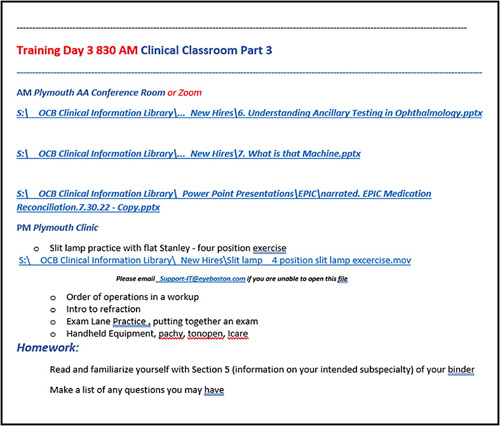Among ophthalmology practices, there is a constant need to train entry level technicians and scribes. Training takes valuable time from the practice’s busy day, so it’s tempting to get it done as quickly as possible. However, training new staff correctly from the start will save you the aggravation of having to retrain them later as well as the concern of having them train someone else incorrectly. More importantly, it is key to consistently good patient outcomes.
Research demonstrates that a structured on-the-job training program is more cost effective (in terms of the supervisor’s time) than informal training and produces faster results and a higher-quality employee.1 Having a structured program also eliminates the informal peer-to-peer training that produces inconsistent results and ineffective work-up practices. Another critical consideration: Appropriate training enables you to impress patients with your staff’s level of professionalism.
The idea of creating an in-house training program for technicians and scribes can seem daunting, but having a clear, structured, and organized program as part of your on-boarding process will produce many benefits. Here’s how we do it at Ophthalmic Consultants of Boston.
First, select for what can’t be taught
Ophthalmic Consultants of Boston is a large multi-specialty group with 17 locations and more than 300 technicians. Though we have training programs in place for all levels of staff, we have found that entry level staff benefit greatly from a structured on-the-job training program.
Choosing the right candidate is extremely important. While it would be nice for the new hire to have medical experience, it really isn’t necessary. Having people skills, a customer service mindset, and the ability to multi-task may be more important in a candidate. For instance, people who have experience as a waiter or waitress often make excellent technicians. They have a lot of experience multi-tasking, can work in a fast-paced environment, and know how to treat customers. The skills needed to workup an ophthalmic patient can be taught. We like to emphasize to potential new hires the great opportunity it is to be chosen for our training program and how a career as an ophthalmic technician can be very fulfilling.
Then, techs learn by watching
New hires who do not possess ophthalmic experience first spend a week in the clinic to observe different positions and see the overall workflow of the clinic before training begins. They observe patients who are being worked up by an experienced technician. In the exam room, they watch the scribes, learning how they interact with the physician and the patient. In the diagnostic department, they observe testing and learn which tests are requested for the different subspecialties.
This process gives new hires a sound base on which to start their training.
Next, provide education
Our new hires then spend two weeks in a classroom setting. Each is given a new-hire notebook. These notebooks contain many helpful handouts such as medical terminology, common abbreviations, and chapters that go into more depth on cataracts, glaucoma, retina, cornea, and plastics (Figure).

We also provide a schedule for the two weeks, so the new employee knows what to expect. The electronic version of the schedule includes links to helpful information.
In the classroom, we start with an ophthalmic medical assisting overview presentation to give the new employees a better understanding of their new role as ophthalmic technicians. This presentation covers professions within ophthalmology, explaining the role of an ophthalmologist, optometrist, optician, and so on. We review the various levels of national certification and our internal certification program. Ethics and professional behavior are both reviewed as well.
We then review the various parts of the comprehensive medical eye exam, the testing that is performed, and how to document this in the medical record. Each following day, we review information on the various subspecialties in ophthalmology and the skills required to work up those patients. We have the new hires spend the morning in a classroom learning environment and the afternoon practicing the skills they have learned.
The new hires break up into groups facilitated by the training manager. They take turns checking visions on each other, reading glasses on a manual lensometer, role-playing questions to ask for a chief complaint, and entering that information correctly into the EMR system.
Final step: Provide mentoring
Once trainees have completed the two-week classroom training, they are assigned a senior level staff member as a mentor. They shadow this mentor in clinic, working as a scribe while the senior-level staff is working up patients, and eventually working up patients as the senior-level staff member observes their work. As trainees take on different parts of the patient work-up, these skills are supplemented with information from their new hire notebooks.
Once the new hire has the skills to complete our entry level skill evaluation, the mentor receives a stipend for their training efforts. Depending upon the employee and the position they will be filling in clinic, it is usually a 3-month process before they are working independently. New employees can continue to reach out to their assigned mentors for support.
Worth the time and effort
By taking steps to create a comprehensive training program now, you will reap benefits for years to come. The staff will benefit from being trained properly, patients will receive a higher level of care — and a consistent level of care — from these expertly trained technicians, and practitioners will benefit by being presented with complete, accurate, and problem-focused exams.
Structured on-the-job training is planned, it’s prioritized, and it’s scheduled. The trainers themselves are trained, and the trainees learn quickly and correctly. The trainees are evaluated along the way, and results are documented. That documentation supports the standardized program. OP
REFERENCE
- Ahadi S, Jacobs RL. A Review of the Literature on Structured On-the-Job Training and Directions for Future Research. Human Resource Development Review. 2017;16(4):323-349.









